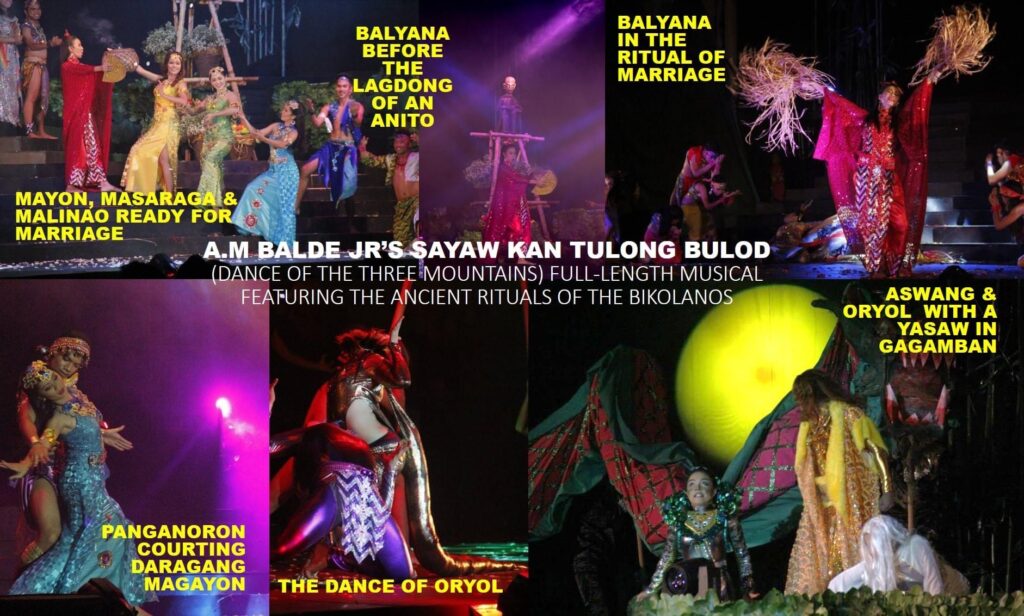By Abdon M. Balde Jr.
THE RITUALS OF ANCIENT BIKOLANOS
We learned about the religion, beliefs, and superstitions of our ancestors thru the writings of the Spanish chroniclers and writers who came to the region to colonize us and to impose their Catholic religion. Again, many of these were written by Fray Jose Castano, Ignacio Alcina, Pedro de Chirino as well as from some local researchers such as Jose Calleja Reyes, Merito B. Espinas, Mariano Goyena del Prado, Elias Ataviado, and from local story tellers.
Here are some of the most popular rituals performed by our ancestors:
ATANG was the votive offering usually performed during harvest time aimed at thanking the good god Gugurang for blessings received and to pray for more sustained livelihood. During the Atang, the natives offer the best of their harvests such as rice, fruits and vegetables. Some also bring their catch of the day, which include cooked meat of boar and deer, fish from the forest or birds trapped in the forest. The Atang was performed inside a structure called Gulanggulangan, inside of which was an altar called Salangat. On the altar were the carved wooden images of Anitos—who were believed to be the ancestors who remain on earth to take care of their descendants. A Balyana lead the ritual by chanting hymns called Soraki and leading the prayers to Gugurang and other deities.
After the Atang, a village feast would follow. The participants in the Atang would partake of all the offerings on the Salangat as they continue celebrating with street dances and singing. The celebration continued in the houses where food were offered on tables and benches on their yard for anyone—even strangers who visit the village and join in the merrymaking. These visitors were free to enter any yard and partake of the food being offered. In fact, it was the source of pride of any household whose yard had the most number of visitors. It meant that the food was good and that they were the most hospitable.
When the Spanish colonizers came, they introduced the Catholic religion. One reason why it was easy for them to convert the Bikolanos is because the new religion was pretty much the same as the old one. Gugurang was replaced by the ONE GOD, personified by Jesus Christ. The ritual of Atang became the HOLY MASS performed inside a structure called an Iglesia; and instead of a Balyana, they had a priest who chanted hymns and recited prayers. The SALANGAT became the ALTAR, and the LAGDONG was replaced by the images of SAINTS. Instead of offering fruits and meat, they had the bread and wine signifying the body and blood of Jesus.The village fiesta was then celebrated in honor of a saint, the most popular of whom was San Isidro Labrador—the patron saint of laborers and farmers.
The celebration of the village fiesta—which started with the mass—would continue in the houses, where every household would offer food for invited guests, village visitors or even strangers who just happened to be passing by. In fact an owner of a house with a banquet on his yard would feel aggrieved if an acquaintance would bypass him and partake of the feast of his neighbor. A house with a big banquet would even go to the extent of hiring barkers or young lads and girls who would stand on the roadside to entice visitors to partake of his food offerings.
These fiesta practices continued up to the early 1960s before modernity, the changing norms and the high cost of living encouraged the households to be more modest in their celebrations and discreet in choosing the visitors who could enter the house and partake of the food offerings. Later on, fiestas and banquets were only practiced in the provinces—especially in remote villages where people are slow to change and continue to cling to their old traditions. This is true with some tribes in remote places, such as the aboriginal natives called Agta in the islands of Batan and RapuRapu and in the hinterlands of Tiwi, Nabua, and Buhi. For some of these natives, the age-old tradition of atang and fiestas are still etched deeply in their collective memory.
HALIA was a ritual done when the moon was full. The tribesmen went out of their houses, gathered in the streets and made all kinds of noise to drive away the serpent Bakunawa from swallowing the moon. The ritual was also intended to drive away evil spirits.
The other rituals are:
PAG-AGOM was the ritual of marriage where a suitor married the maiden he fell in love with.
TAGAY: offered by farmers, fishermen and hunters for good catch and harvest;
DUSAY: for getting rid of rats and other pests;
PAGBAWI: for exorcising evil spirits;
PAGBULONG, PAGSANTIGWAR: for healing;
PAGTAMBAL: for neutralizing venom of snakes and serpents;
GABAS: for acquiring special powers such as anting-anting and mutya.

